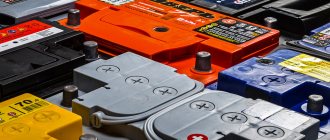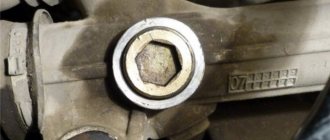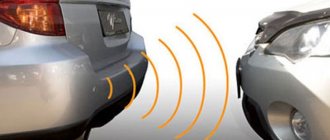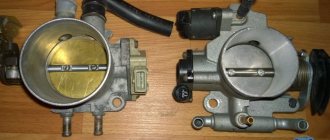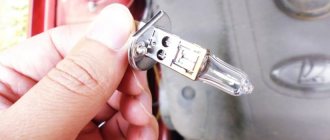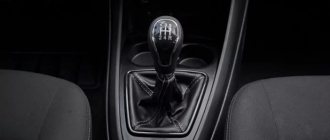Battery manufacturers are not standing still and are trying to simplify the maintenance tasks for car owners. If previously you could only find serviced batteries, into which you had to add distilled water or electrolyte, now most batteries are of the maintenance-free type.
And here the question naturally arises about how to work with them correctly and what you need to know about the charging process. After all, monitoring the boiling of the electrolyte is frankly problematic. Plus, there are no unscrewing plugs through which liquid could be added if necessary.
If you are dealing with a maintenance-free battery, be sure to figure out how to charge them.
What are the features of the battery?
I think it won’t be difficult to remember or imagine a classic battery of a serviceable type. During its maintenance I had to deal with the following phenomena:
- Checking the level and condition of the electrolyte. It was easy to get injured due to a spark or the liquid itself.
- Topping up the mixture. Usually water or a ready-made electrolyte was added. This is a dangerous acid that can cause chemical burns.
Having disassembled maintenance-free car batteries, looking at their advantages and disadvantages, you will draw the appropriate conclusions for yourself.
Choosing the type in question means that you are thinking about your own safety and health.
Maintenance-free batteries are batteries that do not have direct access to the internal plates and banks. Such batteries are usually calcium or hybrid.
Knowing and understanding what a maintenance-free car battery means, it’s worth moving on to considering its strengths and weaknesses.
In many ways, they become the determining factor when purchasing a new battery.
It is logical to assume that maintenance-free car batteries have not only advantages, but also disadvantages.
Positive qualities include:
- ability to hold a charge for a long time;
- improved plate design;
- water does not evaporate;
- special valves are provided for steam release;
- the electrolyte is not liquid, but rather gel-like;
- increased service life;
- Ability to work with modern and demanding vehicles.
Yes, the service life of a maintenance-free battery is one of the main reasons for choosing it. A serviced car battery has a shorter interval between replacements.
A conditional disadvantage is the presence of an impenetrable housing. That is, you won’t be able to open it. But whether it is necessary to open it when it is possible to charge the battery is a moot point.
And the main disadvantage is the cost. It is higher in comparison with serviced analogues. But it would be fair to say that such costs are fully justified. The main thing here is to initially take a device from a trusted manufacturer and make sure that it is not a fake.
Compare the advantages that maintenance-free batteries have and their disadvantages, drawing conclusions for yourself.
When may you need to charge?
Motorists are wondering if they can charge their maintenance-free batteries if the manufacturer claims there is no such need.
In fact, you can charge them. And sometimes it's even necessary.
Manufacturers claim that their batteries are autonomous and independent. But this is only under ideal operating conditions. If everything is fine with the generator, the current regulator does its job perfectly, and the need for charging is unlikely to arise. After all, the battery will receive the necessary charge and compensate for all losses on the starter, radio operation, etc.
In practice, good maintenance-free batteries last the first 2-3 years without any complaints.
But there are factors that may require charging.
- City driving. Many motorists move around the city and that’s all. Moreover, the runs are small, the trips are short. The generator simply does not have enough time to compensate for the charge. To fully charge, you need to travel about 50-100 km. Without stops. In the city they usually travel 30-40 km. per day, but constantly stopping at the same time. The battery will lose approximately 50% of its charge.
- Relay regulator. This is a device that controls the supply of correct and stable voltage through the generator to the battery. If the relay or the generator itself does not work correctly, there are breakdowns or malfunctions, then the battery may also not receive enough charge.
- Frost. Low negative temperatures also reduce the charge in the battery.
If a maintenance-free battery is completely discharged, it will be almost impossible to restore it.
Access to the contents of the case is closed, so it is not possible to supplement the battery with conductive liquid. And if the electrolyte boils away, which negatively affects the capacity.
So it turns out that in terms of care and condition monitoring, such batteries can be considered even more demanding than their serviced counterparts. If you allow a deep discharge, you may not be able to restore the battery. This means the need to purchase a new device.
Since a motorist is not able to control absolutely everything, sometimes it is more logical and correct to simply charge the battery.
Possible problems
Is your car battery not charging from the alternator even though the car is used regularly? There are many reasons for this. Let's take a closer look at those that motorists most often encounter.
The generator works but does not charge the battery
The battery icon, glowing red on the dashboard when the car is moving, indicates that due to a combination of circumstances, the battery has stopped receiving energy from the generating device. That is, the generator works, but for some reason does not charge the battery. The root cause may be hidden both in the generating device itself and in the battery. Initially, you should determine the reason for the current leak, and in addition, measure the voltage at the terminals, check the level and density of the electrolyte, which in most cases will allow you to identify the culprit of the malfunction. Usually the reason is as follows:
- Burnt fuse. When this happens in the battery circuit, charging will not go directly to the battery; the remaining electrical consumers of the car will operate as normal. In addition, the voltmeter will show the presence of voltage in the on-board network.
- The generator belt is broken or its tension is loose. In such a situation, under load, the generating device will “slip”: the belt slips on the pulley, making whistling sounds. When the headlights are turned on, the indicator on the panel indicating that the battery is low will light up. Eliminate the cause of the malfunction by replacing the belt, adjusting its tension.
- Damage to contacts or wiring. Oxidized battery terminals contribute to current leakage and do not allow the battery to accept charge from the generator. The condition of the contacts should be checked not only on the battery itself, but also on the generating device, as well as on the vehicle’s ground. The oxide is removed by cleaning or with a special lubricant. The generator is connected directly to the battery with a thick wire. If it is damaged or has manufacturing defects, the battery will not be charged.
Charging "jumps"
Sometimes the generator charging current can fluctuate over a wide range. This affects not only the full supply of energy to the battery, but also other consumers: dim headlights, the interior light bulb blinks, the radio operates intermittently. The main reasons for the instability of the amount of incoming charge:
- The generator regulator is faulty. The device, which is a relay, must ensure the voltage of the on-board network is within acceptable limits, regardless of the load, temperature conditions, and shaft speed. The sensor device is nothing more than a conventional electronic circuit with outputs to graphite brushes. Equipment malfunction may be caused by:
- poor contact between wires or a break in the electrical circuit;
- incorrect adjustment;
- short circuit between contacts;
- sintering of contacts, breakage of the armature spring. Damage to the device usually manifests itself in a regular lack of battery charge or, conversely, its excess. You can check the device's functionality using a tester set to voltmeter mode.
- Failure of the diode bridge. The structural element of the generator performs the functions of a collector, replacing it. A bridge circuit is necessary to equalize the ripple of alternating current and convert it to direct current. The main factors leading to failure:
- problems with the battery - low electrolyte density or short circuit of its cans;
- incorrectly performed “lighting” from another car;
- dirt or moisture that has penetrated inside the generator housing.
Signs of malfunction:
- instant discharge of a fully charged battery;
- the appearance of whistling sounds from under the hood when starting the engine or while driving;
- a steering fault is displayed on the display and the power steering stops working;
- headlights dim quickly when driving;
- The car radio and air conditioner turn off.
In addition, there are several situations when the battery will be discharged intensively, but this is not associated with malfunctions in the generator-battery system:
- The battery is reaching the end of its factory life.
- Rare trips over short distances with a full electrical load - the maximum number of consumers is turned on: headlights, radio, air conditioning, and so on.
- Standing idle in traffic jams for many hours with the engine running.
How to charge
Now directly about how to properly charge your maintenance-free battery and what you need to know to do this.
The procedure can be performed in 2 ways.
- D.C. Here the initial current parameters will not change. But you will need to change the voltage supply. For example, the direct current will be 2 A, and the voltage will initially be 14.8, and by the end of the procedure it will drop to 14.3 V.
- Constant pressure. Here the initial voltage will not change, but the current value is adjusted. For example, the voltage is initially set to 14.4 V, otherwise it will be 10 A. By the end of the charge, the current drops to 0.2 A.
In the case of maintenance-free batteries, due to the hermetically sealed housing, it is under no circumstances possible to set the charging voltage above 15 V.
Self-charging a maintenance-free battery from a car, carried out at home, should not cause any special problems when using modern chargers.
You can give approximate instructions on how to properly charge maintenance-free car batteries:
- The battery is placed on a flat surface. But you can also leave it in the engine compartment, observing safety precautions.
- Next, connect the crocodiles from the charger, observing the polarity.
- Take measurements of the current voltage from the battery. If the charge drops to 11 V, there is no point in charging. This indicates a deep discharge, after which the device cannot be restored.
- Calculate the charging time based on the output voltage data.
- Apply a voltage of 12.6 V. Observe the battery for the first 30 minutes. If the electrolyte has not begun to boil, the voltage can be raised to 14.4 V.
- At the same time, watch how the readings on the ammeter drop. As soon as they reach the lower limit of 0.5-1 A, the charger can be turned off.
This will allow you to understand how to properly charge your maintenance-free battery if you use a regular inexpensive battery charger. Modern charging has been improved, and all you need to do is connect the terminals, plug it in and start the process. The automation itself will turn off the charge when it reaches the required values.
Based on the instructions presented, you can recharge your maintenance-free battery yourself. If the procedure is performed without removing it from the vehicle, make sure that all energy consumers are turned off.
The optimal solution would be to use automatic storage. With its help, charging a dead, maintenance-free battery at home is a pleasure.
In the first hour of operation, such batteries provide maximum current, in the second hour they reduce it by 2-3 times, and after 5 hours the process proceeds at minimum values.
The use of automatic chargers allows you to make the correct charge and prevent the electrolyte from boiling.
So, whenever possible, use these charging stations.
Charging device
Can standard chargers be used or do they need to be purchased separately? There are no restrictions on this criterion, and you can charge a maintenance-free battery with any chargers.
Battery charger
Charger models used when charging low-maintenance batteries are fully suitable. It is recommended to use voltage controlled equipment.
There are devices called automatic charging stations - they themselves select the current values and the correct charging method. Using devices of this type, there is no need to monitor the charging process, and the battery will never boil - when fully charged, minimal currents are supplied, or the device turns off.
Checking the electrolyte level
Many people are interested in how to maintain their maintenance-free battery if there are no caps and there is no access to the banks.
In fact, such batteries may not require maintenance if you follow all the rules and charge the battery in a timely manner.
But sometimes it becomes necessary to add water or electrolyte so that a maintenance-free car battery continues to function properly.
Before pouring the distilled composition, it is important to understand how you can check the liquid level in general.
Manufacturers have provided for this. And they offer 2 ways.
- Max and Min marks. They are located on the case and indicate the charge level. They are applied on a special window. If there are no marks, then you can find a battery with a transparent part of the case.
- Indicators. Some manufacturers have indicators that allow you to find out the approximate level. They are made in several colors. Most often, green means full charge, white means medium, and red or black means critical.
Such verification methods cannot be called reliable.
It is not entirely clear what to do if you need to add distillate, but there are no holes for this. There are again 2 options. Use a trick or just buy a new battery.
You can add fluid to a maintenance-free battery as follows:
- use transparent areas to find jars and partitions;
- determine places to fill liquid or check density;
- use an awl to make a neat hole;
- through it, where there is a density indicator, 5 ml of distillate is poured;
- it is most convenient to do this with syringes;
- when the indicator turns white or green, add another 20 ml.
If there are no transparent areas, you will have to act blindly. To do this, insert the syringe into the body to a certain depth, pulling the rod towards you. When the liquid begins to fill the syringe, a mark is made. Only then, according to this mark, the composition is added.
Can I charge at home?
The maintenance-free type of batteries can be charged at home without worry. Many people do not recommend charging car batteries in residential areas, since when the electrolyte boils, substances harmful to health are released into the air.
But in an unattended state, this does not happen, even if there is a possibility of overcharging. The battery case is completely sealed. And if you exclude the possibility of overcharging, then the option of charging at home is harmless.
There are also maintenance-free batteries with charge indicators. You need to remove it from charging when the indicator window turns green.
Charging time
If you do not have an automatic charger, you will have to carry out calculations to determine the time spent on charging. Here you will need to know the degree of discharge and capacity.
- When the battery is fully charged, the voltage will be 12.6-12.7 V. For discharged batteries it is 116.-11.7 V. When the charge is average, it is 12.1-12.2 V.
- That is, between a full charge and a full discharge, the difference is about 1 V. You need to take 10% of this value, that is, 0.1 V.
- If the battery capacity is 60 Ah, the discharge level at 12.1-12.2 V will be 50%. And this is 30 A.
- Maintenance-free batteries are charged with a current of 10% of capacity. If it is 60 Ah, the current will be 6 A.
- To compensate for the wasted 30 A, a minimum of 5 hours is required.
Conventionally, a 60 Ah capacity is charged in 10 hours, since a current of 6 A is supplied. For every hour, a charge of 6 Amperes is replenished. Since the loss was, say, 30 A, then it will take 5 hours.
The calculation is not difficult, so everyone should cope with this task.
What happens in case of overcharging?
Maintenance-free batteries should not be allowed to be recharged.
Otherwise, this may lead to the following consequences:
- the electrolyte will boil, as a result of which the internal elements will begin to corrode;
- the acid will spread throughout the terminals, oxidize and create plaque;
- if the liquid is outside the battery, the plates will be exposed, and then they will fall off;
- the possibility of a battery case rupture cannot be ruled out;
- the battery will need to be replaced.
The consequences are quite obvious and predictable. Therefore, it is important to be careful and adhere to the charging and operating rules.
Differences between maintenance-free batteries and serviced ones
There are three types of maintenance-free batteries on sale, made using different technologies:
- batteries with liquid electrolyte;
- AGM batteries;
- GEL batteries.
All three types are lead-acid and have the same operating principle. How do they differ from regular serviced ones?
